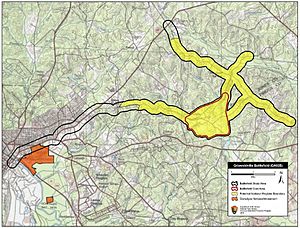Battle of Griswoldville facts for kids
Quick facts for kids Battle of Griswoldville |
|||||||
|---|---|---|---|---|---|---|---|
| Part of the American Civil War | |||||||
|
|||||||
| Belligerents | |||||||
| Commanders and leaders | |||||||
| Charles C. Walcutt Charles R. Woods |
Joseph Wheeler Pleasant J. Philips |
||||||
| Strength | |||||||
| 3,000 | 2,300 | ||||||
| Casualties and losses | |||||||
| 94 total, 13 dead, 79 wounded, 2 captured |
523 total, |
||||||
The Battle of Griswoldville was the very first battle during Sherman's March to the Sea. This important march happened in the American Civil War. The battle took place on November 22, 1864. A group of Union Army soldiers, called a brigade (about 3,000 men), led by General Charles C. Walcutt, fought against three groups of Georgia militia. Militia were regular citizens, not full-time soldiers, who were called to fight. The battle happened in Griswoldville, which was an industrial town near Macon, Georgia. After the battle, the Union army continued its march toward Savannah.
Contents
Why the Battle Happened
After winning the long Atlanta Campaign, General William Tecumseh Sherman and his Union army were ready for their next big move. They left Atlanta and began a march designed to reach the Atlantic Ocean at Savannah. This famous journey is known as Sherman's March to the Sea.
The right side of Sherman's army, led by General Oliver Otis Howard, was the first to meet resistance. This happened in Griswoldville. General Walcutt was told to send his brigade (a large group of soldiers) toward Macon. He needed to see how many enemy troops were in that area.
Union cavalry (soldiers on horseback) under General Hugh Judson Kilpatrick had already been to Griswoldville on November 21. They captured a train with 13 cars full of military supplies. They also burned the train station and some factory buildings.
The Battle Begins
On the morning of November 22, Confederate cavalry, led by General Joseph Wheeler, attacked the Union's 9th Pennsylvania Cavalry. This happened on the Gordon Road. The Confederates killed one Union soldier, wounded two, and captured eighteen.
The 9th Pennsylvania Cavalry then fought back. They chased the Confederates almost a mile across a creek. There, they found a large group of enemy soldiers ready for battle. The Confederates moved forward and pushed back the Union's skirmishers (soldiers who fight in small, scattered groups).
However, the 9th Pennsylvania and 5th Kentucky Cavalry charged with their swords. This forced the Confederates to go back to their defenses. At this point, General Walcutt's infantry brigade (foot soldiers) and artillery (cannons) joined the cavalry.
Fighting in Griswoldville
General Walcutt sent out a strong line of skirmishers. They pushed the Confederates back through Griswoldville. Then, following orders, Walcutt moved his troops back to the Duncan farm. He set up his soldiers at the edge of a forest. There was an open field in front of them. Swamps protected their sides.
The Union soldiers quickly built a barricade using rails and logs. Cannons were also brought into position. Around 2 p.m., three brigades of Georgia militia attacked. These militia groups were led by General Pleasant J. Philips. They had been ordered to go from Macon to Augusta. They thought Augusta was Sherman's next target. They accidentally ran into Walcutt's Union force.
The militia advanced in three close lines. But they were met with a lot of canister shot (a type of cannon ammunition that acts like a giant shotgun blast). Even so, they managed to reach a ditch about 75 yards from Walcutt's defenses. There, they regrouped.
From the ditch, they made three very brave charges on the Union position. All of these attacks were pushed back. The Confederates suffered heavy losses. The militia then tried to go around the sides of the Union lines. But they found these areas were well protected by Union cavalry. So, they went back to the ditch. They stayed there until dark, then left the battlefield. General Walcutt was wounded early in the fight. Colonel Robert Francis Catterson took command of the brigade.
What Happened Next
The Union army had 13 soldiers killed, 79 wounded, and two missing. The Confederate militia had much higher losses. About 51 of their soldiers were killed, 472 were wounded, and around 600 were captured. After this battle, General William Tecumseh Sherman's march to the sea continued.
After the Civil War ended, the industrial town of Griswoldville was not rebuilt. It had been an important place for making Confederate military supplies during the war.
Protecting the Battlefield
Today, parts of the Griswoldville battlefield are being preserved. The Civil War Trust, which is part of the American Battlefield Trust, has saved a 17-acre piece of the battlefield. This land is managed by Georgia State Parks. You can find a monument and signs with information at the site on Baker Road, near the intersection with Griswoldville Road.


